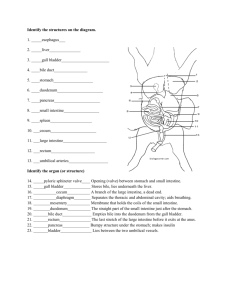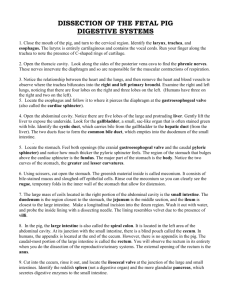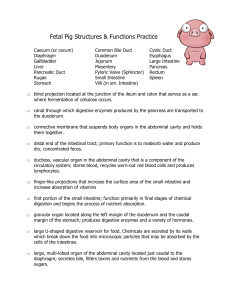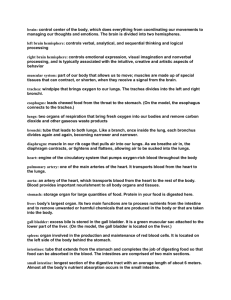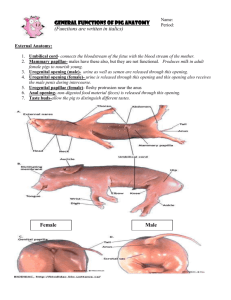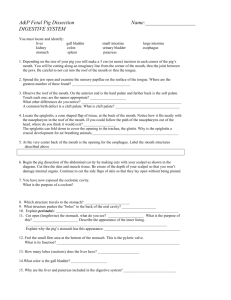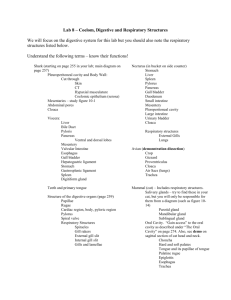Day 2: Digestive and Excretory Systems
advertisement
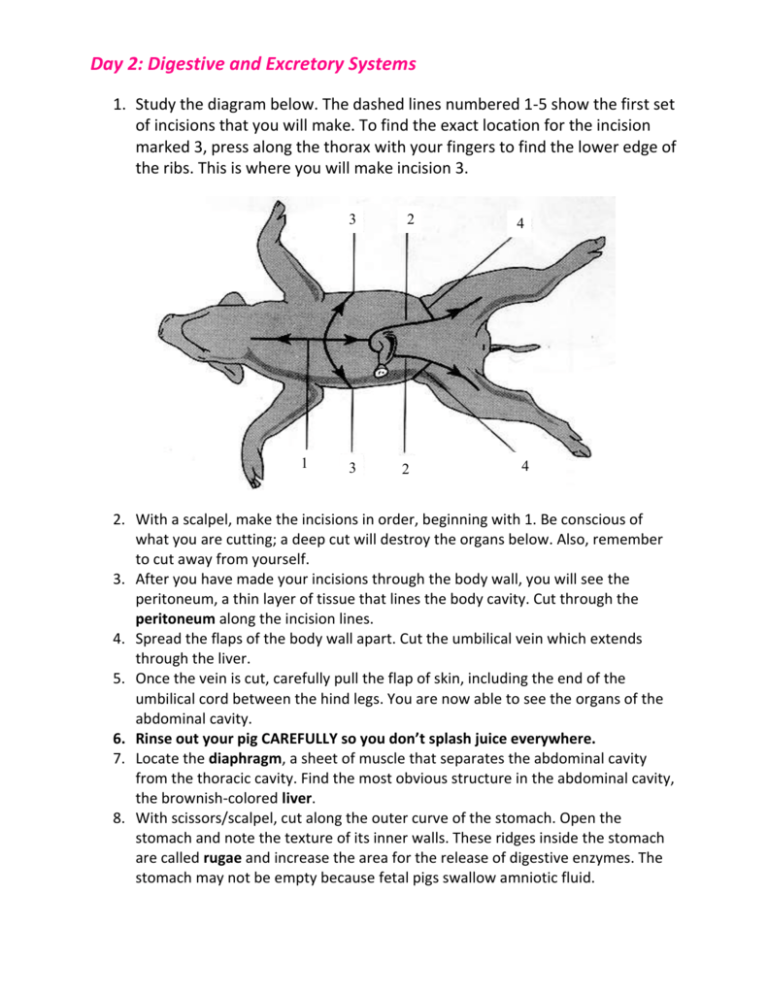
Day 2: Digestive and Excretory Systems 1. Study the diagram below. The dashed lines numbered 1-5 show the first set of incisions that you will make. To find the exact location for the incision marked 3, press along the thorax with your fingers to find the lower edge of the ribs. This is where you will make incision 3. 3 1 3 2 2 4 4 2. With a scalpel, make the incisions in order, beginning with 1. Be conscious of what you are cutting; a deep cut will destroy the organs below. Also, remember to cut away from yourself. 3. After you have made your incisions through the body wall, you will see the peritoneum, a thin layer of tissue that lines the body cavity. Cut through the peritoneum along the incision lines. 4. Spread the flaps of the body wall apart. Cut the umbilical vein which extends through the liver. 5. Once the vein is cut, carefully pull the flap of skin, including the end of the umbilical cord between the hind legs. You are now able to see the organs of the abdominal cavity. 6. Rinse out your pig CAREFULLY so you don’t splash juice everywhere. 7. Locate the diaphragm, a sheet of muscle that separates the abdominal cavity from the thoracic cavity. Find the most obvious structure in the abdominal cavity, the brownish-colored liver. 8. With scissors/scalpel, cut along the outer curve of the stomach. Open the stomach and note the texture of its inner walls. These ridges inside the stomach are called rugae and increase the area for the release of digestive enzymes. The stomach may not be empty because fetal pigs swallow amniotic fluid. 9. Identify the first part of the small intestine, the U-shaped duodenum, which connects to the lower end of the stomach. Pancreatic juices, made by the pancreas, and bile, made by the liver and stored in the gall bladder, are added to food here to continue digestion. 10. Study the rest of the small intestine. Notice that it is a coiled, narrow tube, held together by tissue called mesentery. The soupy, partly digested food that enters the small intestine from the stomach is called chyme. 11. Notice that the large intestine, also known as the colon leads into the rectum, a tube that runs posteriorly along the dorsal body wall. The rectum carries wastes to the opening called the anus where they are eliminated. 12. Locate the thin, white pancreas beneath the stomach and duodenum. Pancreatic juice flows through pancreatic ducts to the duodenum. 13. Between the lobes of the liver, find the small, greenish-brown gall bladder. 14. Remove the digestive organs to study the excretory organs that make up the urogenital system. 15. Locate the large, bean-shaped kidneys lying against the dorsal body wall. Notice that they are covered by the peritoneum. Kidneys filter wastes from blood. 16. Find the ureters, tubes which extend from the kidneys to the bag-like urinary bladder. The urinary bladder lies between the umbilical arteries and temporarily stores liquid wastes filtered from the blood. 17. Lift the urinary bladder to find the urethra, the tube which carries urine out of the body. Follow the urethra to the urogenital opening on the outside of the pig's body. ***TODAYS CONTEST*** 18. Carefully cut through the mesentery and uncoil the small intestine. Note and record its length in centimeters. The top two teams with the longest unbroken section of small intestine wins a prize!!! Wrap up all removed organs inside the dissection pad & throw it away. Return your pig to their plastic bag & place your pig in your class periods tub. Wash and DRY your utensils. Wipe your table down with a disinfectant wipe. Make sure your table is dry & place a new dissection pad out for the next group.
